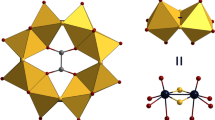Abstract
The mode of decomposition of complexes involving biologically important ligands such as thiouracil and xanthine coordinated to some group VIII metals has been studies by thermogravimetry. The results show that the complex tris-(dithiouracil) trichlororhodium(III) is monomeric and not polymeric as suggested previously. The decomposition behavior of the complex indicates that after the initial loss of a ligand molecule to form a four-coordinate complex, further ligand removal takes place in one sharp step. In the case of the complexes bis-(3-methylxanthine) diammineplatinum(II) and bis-(9-methylxanthine) diamminepalladium(II), ammonia comes off first, followed by rapid loss of the remaining xanthine ligands. Moreover, the activation energy determined for the main decomposition step suggests that the breakdown of the xanthine ligand involves the initial cleavage of the pyrimidine moiety, followed closely by loss of the remaining imidazole portion.
Zusammenfassung
Die Art der Zersetzung von Komplexen einiger Metalle der VIII. Gruppe mit biologisch wichtigen Liganden, wie Thiouracil and Xanthin, wurde thermogravimetrisch untersucht. Die Ergebnisse zeigen, daß der Komplex Tris-(dithiouracil) trichlororhodium(III) monomer und nicht — wie früher vermutet — polymer ist. Das Zersetzungsverhalten des Komplexes zeigt, daß nach dem zu einem tetrakoordinierten Komplex führenden Verlust eines Ligandmoleküls die Abgabe eines weiteren Liganden in einem scharfen Schritt erfolgt. Im Falle der Komplexe Bis-(3-methylxanthin) diamminplatin(II) und Bis-(9-methylxanthin) diamminpalladium(II) erfolgt zunächst eine Abspaltung von Ammoniak, der ein schneller Verlust der verbleibenden Xanthinliganden folgt. Die für die Hauptzersetzungsreaktion bestimmte Aktivierungsenergie läßt vermuten, daß der Abbau der Xanthinliganden über eine Spaltung des Pyrimidinteils verläuft, der schnell die Abgabe des verbleibenden Imidazolteils folgt.
Резюме
Термогравиметричес ким методом изучена реакция разложения к омплексов таких биологически а ктивных лигандов, как тиоурацил и ксантин, с металлами VIII группы. Результаты показали, что комплекс трис-(дитиоурацил) три хлороро дий (III) являетс я мономерым, а не полиме рным, как это ранее предполагалось. Этот комплекс в начальной стадии разложения те ряет одну молекулу ли ганда с образованием четыре хкоординационно-го комплекса, который за тем разлагается в одн у стадию с потерей молекул лига ндов. В случае комплексов би с- (3-метилксантин) диамминоплатинз (II) и би с-(9 -метилксантин) ди-ам минопалладий(II) ди-амминопалладий(II) сначала происходит в ыделение аммиака, за к оторым следует быстрое выделение оставшихс я молекул ксантина. Кр оме того, энергия активации, оп ределенная для главной стадии ра зложения, указывает, ч то разрыв молекул ксантина пер воначально происходит с расщепл ением пиримидиновой составляющей с после дующим выделением оставшейся имидазол ьной части.
Similar content being viewed by others
References
A. W. Prestako, S. T. Crooke and S. W. Carter, Eds., Cis-platin-Current Status and New Developments, Academic Press, New York, 1980.
A. P. Zipp and S. G. Zipp, J. Chem. Educ., 54 (1977) 739.
R. M. Izatt, J. J. Christensen and J. H. Rytting, Chem. Rev., 71 (1971) 439.
G. L. Eichhorn, Ed., Inorganic Biochemistry, Elsevier, Amsterdam, 1973.
D. J. Hodgson, Prog. Inorg. Chem., 23 (1977) 211.
R. W. Gellert and P. Bau, Metal Ions in Biological Systems, Vol. 8, Marcel Dekker, New York, 1979.
W. Szer and S. Ochoa, J. Mol. Biol., 8 (1964) 823.
P. J. Stone, A. Kellman, F. M. Sinex, M. M. Bhargara and H. O. Halvorsen, J. Mol. Biol., 104 (1976) 793.
K. Inagaki and Y. Kidani, J. Inorg. Biochem., 11 (1979) 39.
S. Mansy, G. Y. Chu, R. E. Duncan and R. S. Tobias, J. Am. Chem. Soc., 100 (1978) 607.
J. P. Marquet and T. Theophanides, Bioinorg. Chem., 5 (1979) 59.
J. Dehand and J. Jordanov, J. Chem. Soc., Chem. Comm. (1976) 598.
T. Ozawa, Bull. Chem. Soc., Japan, 38 (1965) 1881.
J. R. Lusty, H. S. O. Chan, J. Peeling and M. Jazzar, 66th Canadian Chemical Conference, Calgary, Canada, 1983.
J. S. Dwivedi and U. Agarwala, Indian J. Chem., 10 (1972) 652.
J. S. Dwivedi and U. Agarwala, Indian J. Chem., 10 (1972) 657.
For example see Refs 14 and 15.
N. L. Cull and H. B. Jonassen, Inorg. Synth. (1963) 239.
Author information
Authors and Affiliations
Rights and permissions
About this article
Cite this article
Chan, H.S.O., Lusty, J.R. Thermal studies on some group VIII complexes with biologically active ligands. Journal of Thermal Analysis 30, 25–32 (1985). https://doi.org/10.1007/BF02128111
Issue Date:
DOI: https://doi.org/10.1007/BF02128111




